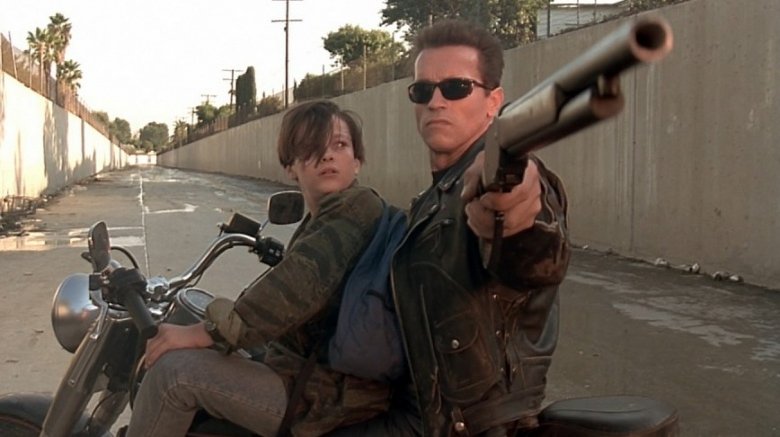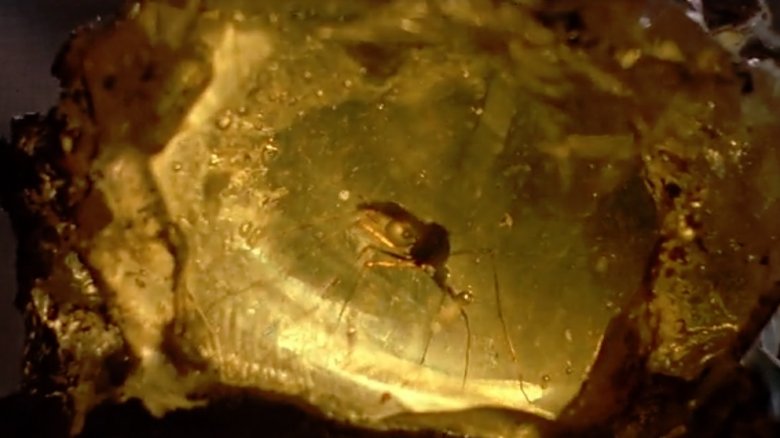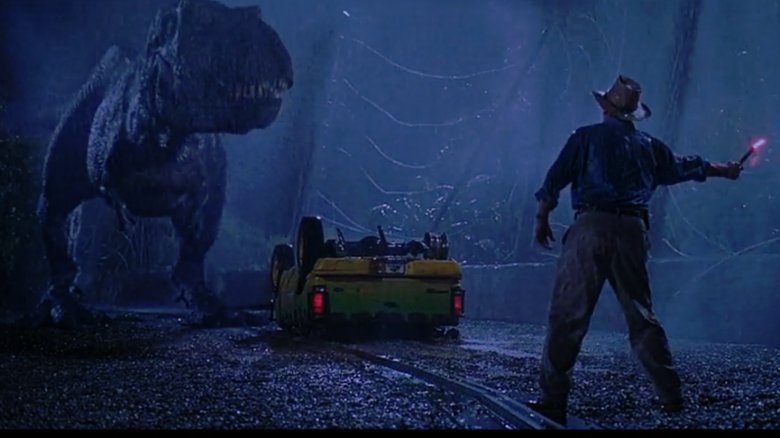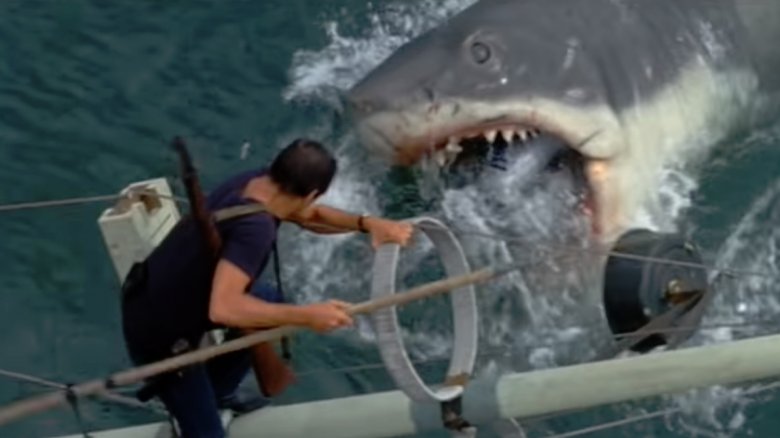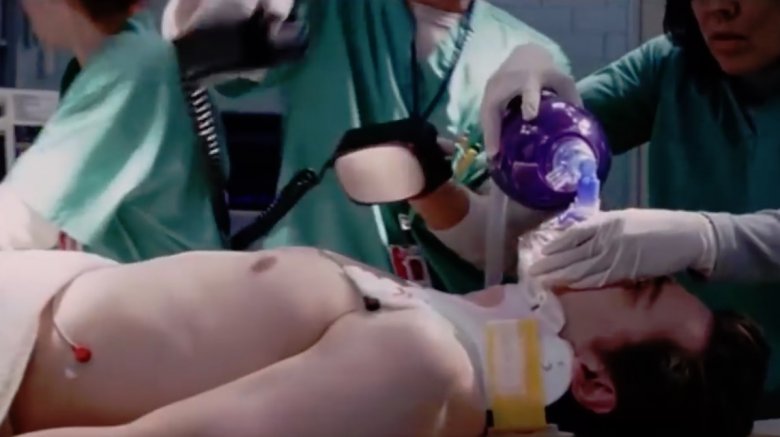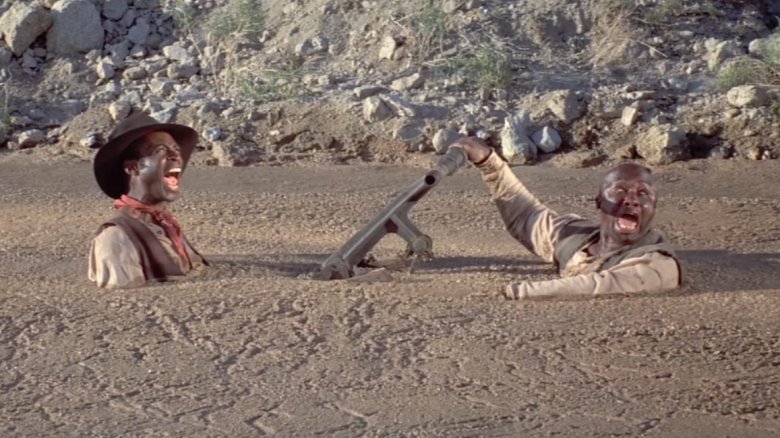Myths Movies Taught You About Science
Hollywood's job is to entertain us, and with the exception of the occasional Nicolas Cage movie, it usually does what it sets out to do. Along the way, though, it has to embellish, because if movies were anything like real life no one would go see them, mostly because they would be super boring. In order for movies to be exciting, things must explode, fly through the air, and happen pretty much immediately so the audience doesn't have to spend too much time waiting around for the real action to start.
So it's not Hollywood's fault that some of those embellishments have, over time, become myths that we believe in. And because it's more fun to believe in things that are big, dramatic, and implausible, we're not exactly eager to find out that so many of our most beloved movies have been deceiving us with half-truths and outright fabrications. But in science, the truth must prevail. Whether you like it or not.
Laser beams come in awesome colors
Lasers are the de facto sci-fi weapon, revered for their ability to make things disintegrate and also because they come in lots of different cool colors.
Laser beam weapons are so ingrained in our collective imagination that you were probably a little confused the first time you played with a laser pointer. What's going on with the dumb dot on the wall? Where is that glorious red beam of matter-disintegrating light? Besides making for a hilarious cat toy, actual laser pointers are lame.
Sci-fi movies have been deceiving us since movie aliens first descended from Mars and pointed their weapons at helpless Earthlings. And although they're based on a real technology, the sad truth is that lasers really are boring. According to How Stuff Works, to make a laser beam visible, just like any beam of light, you have to put particles in its path, so if you toss a handful of ash between a laser and the wall, the ash particles will scatter the light, making it visible. You'll see the same effect with a regular flashlight. In real life? Unless the Enterprise is flying through a cloud of space dust, those cool space battles would be nothing but invisible lasers. Lame.
Boom! You're dead and you also traveled 15 feet backwards
Everyone knows when the good guy pulls out his shotgun that the bad guy is not only toast, he's toast in motion. That shotgun blast will end him spectacularly and also send him flying backward through the air, because as far as bad guy deaths go, it's just not as satisfying if he only just gets shot and falls over.
Unfortunately, shotguns do not send people flying through the air, no matter how big and beefy they are and no matter how Arnold Schwarzenegger-like the guy holding them is. In his book Insultingly Stupid Movie Physics, Tom Rogers says the law of conservation of momentum neatly explains why this doesn't happen in real life. In order for a person to get thrown into the air by a shotgun blast, the recoil from the weapon would also have to throw Arnie (or whoever happens to be holding the weapon) into the air. In fact, because the shooter is getting momentum from the hot gasses coming out of the shotgun as well as the buckshot, and because the buckshot actually slows down as it approaches the victim, you wouldn't expect the victim to fly quite so far as the shooter. So if a movie wanted to feature a flying shotgun victim, for accuracy it should also feature a flying shotgun shooter.
Pew, pew, pew
We have established that you can't see laser beams in space, and we're all pretty sad about that. And because we haven't pooped on enough parties yet, let's go one further and say that you can't actually hear laser beams in space, either. So not only do laser weapons not go "pew, pew, pew," you also won't hear any giant booming sounds when things explode and you won't hear that weird yet awesome weewooweewoo sound as the TARDIS prepares to travel across time and space. That's because there isn't any air in space, and sound needs air to travel.
According to ThoughtCo, sound is basically just our interpretation of vibrations made by various objects, like vocal chords, footsteps, or lasers that make "pew pew" sounds. When an object vibrates, those vibrations are picked up and moved along by molecules of air, traveling in waves until they finally reach someone's ear. Without the air for the sound waves to travel through, and without the ear to pick up and interpret those sound waves, there can be no sound. You can probably see the problem with this right away — there is no air in space (hence the space suits everyone wears when they're up there), so there isn't anything that can pick up those vibrations and move them along. So, no sound, no booming explosions, and no "pew, pew, pew." Space is turning out to be a really disappointing place.
Amber is a handy DNA preservation medium
Remember that moment in the first Jurassic Park movie, when the camera descends upon that piece of amber with the mosquito trapped inside it, and the world has a collective "aha" moment where we realize that all the information we need to resurrect extinct species might lie within a 150-million-year-old wad of tree sap?
It's just a fantasy, not unlike the fantasy that Newman from Seinfeld might finally get his comeuppance from a venom-spewing Jurassic jungle lizard. Because scientists can't even find DNA in 60-year-old copal, which is the sub-fossilized pre-amber version of amber.
According to SciNews, a team of researchers at Manchester University used "sensitive next generation methods" to try and extract DNA from insects preserved in copal, and were unsuccessful. In fact, they determined that the chances of finding DNA in copal were not greater than the chances of finding DNA in a dried up insect corpse pinned to a piece of cardboard somewhere in the cellar of a natural history museum. And a mosquito that happened to feed on a dinosaur that happened to end up preserved in a piece of copal that happened to eventually become a piece of amber would be a couple million times older than insects preserved in a 60-year-old copal sample, so it seems pretty unlikely that anyone will be cloning a T. rex any time soon. And you've seen the movies, so, really, it's probably not a good idea anyway.
If you don't move, T. rex won't eat you
Speaking of dumb Jurassic Park myths, there's also the one about the T. rex's eyesight, which is supposedly super crappy. Now, nature saw fit to endow T. rex with the lamest pair of arms ever, so it seems extra cruel that nature would also endow it with the worst eyesight of any predator ever. But we all remember that famous line from Jurassic Park: "Keep absolutely still. It's vision is based on movement." So it must be true because Hollywood sayeth.
According to IFLScience, in 1993 a scientist named Kent Stevens made some scale models of various dino heads and used them to estimate the depth perception of each species. He used fake eyes to measure each animals' area of view, which allowed him to make educated guesses about how well they could see.
But even that was overkill if you just look at the basic biology of the T. rex. First of all, its eyes were enormous (roughly the size of softballs). Like a typical predator, T. rex had forward-facing eyes. And its skull was narrow, so like us, the fields of vision from each eye overlapped, giving it the ability to judge distance. Based on this information and his own observations, Stevens concluded that the T. rex had excellent vision, around 13 times better than a human. So if you do happen to encounter a T. rex, keeping very, very still is a terrible idea, unless you're actually hoping to become dino-dinner.
A chloroform-soaked handkerchief is like a magic wand for kidnappers
When movie bad guys want to capture someone alive, they soak a piece of cloth in chloroform, put it over their enemy's nose and mouth, and within seconds that person has collapsed. Then they can be more easily placed into some elaborate shark/lava/slow-moving table saw contraption so they can escape at the last minute while simultaneously listening to the bad guy monologue about his evil plans.
But if it were that easy to knock someone out with chloroform, don't you think everyone with evil intentions would be doing it? According to Technology.org, the reason there isn't an epidemic of chloroform-related kidnappings is because it actually takes a really, really long time for chloroform to knock someone out.
This particular myth does have some basis in fact — during the early 20th century, chloroform was used as an anesthetic, which means criminals could easily obtain it. It was the preferred murder weapon for at least one serial killer, and others used it to commit robbery. But for the average would-be kidnapper, chloroform is not really a very effective tool because it can actually take up to five minutes to incapacitate a healthy adult. That's five minutes of trying to keep the cloth in place while engaging in hand-to-hand combat with someone who doesn't appreciate the chloroform-soaked handkerchief thing. So as take-them-alive weapons go, not really very efficient.
Explosions in space are awesome
When the Death Star was destroyed, we all went "Woohoo!" and not just because the explosion killed more than 200,000 super evil people who wore stupid-looking helmets and deserved it, but also because it looked really cool.
Except fireballs don't really happen in outer space, according to the party-poopers hosting a 2012 episode of Astronomy Cast. Evidently, the thing that makes explosions look so cool on Earth is air, and we already know that a lack of air in space also makes laser beams boring and stops the TARDIS from sounding like the TARDIS, so really, we should not be surprised that a lack of air also stops explosions from looking cool.
So basically, air pressure on Earth slows the explosion down enough that you can actually see it. In space, there's no air pressure to slow the explosion, so instead of creating a super cool fire ball it just sort of goes pop, except without the pop because remember there's no sound in space, and then it's over in less than a second. You might see a flash of light, and then you'll have to get out of the way because there's also not going to be any air to slow the approach of all the flying shrapnel. So super boring, until your spacesuit is punctured by a piece of the Death Star, and then really exciting for at least the last few seconds of your life.
Jaws has the nose of a bloodhound
If you poke yourself with a fish hook and let your blood drip into the water, the great white shark that's lurking 700 miles away will smell it and then eat you and your entire boat. Sharks not only have terrifying jaws, dead eyes, and the desire to eat everything in sight even after they've fallen 400 feet out of a tornado, but they also have a scarily accurate sense of smell.
The jury is still out on the whole tornado thing, but LiveScience says in 2010 the "amazing sense of smell" myth was finally put to rest.
First, scientists had to catch a bunch of sharks and shark relatives (fish from the elasmobranchii family). Then they had to attach scientific equipment to each animal's nose, which must have been hilarious and yet somehow terrifying to watch. Next, they made them smell stuff. From there, they figured out that sharks could detect one drop of scent in about a billion drops of water, which sounds impressive until you consider that a billion drops of water is just over 28,500 gallons, which is maybe a little more water than you'd find in the average backyard swimming pool. So the moral of this story is, if you're keeping a great white in your pool, maybe don't poke yourself with a fish hook and bleed into the water. For everywhere else, you're probably relatively safe if a shark is not already close to you. Probably.
If you get hit on the head you'll forget your entire boring life
Who among us hasn't dreamed that a good knock on the back of the head will one day erase all memory of that really embarrassing thing we did the last time we were at a party or, you know, the entire time we worked at Burger King?
One of the most famous Hollywood amnesia victims is Jason Bourne from the Bourne Identity films, who forgot his entire life after a near-drowning experience. Well, if all this scientific mythbusting hasn't messed you up enough, NeuroPsyFi would also like you to know that in real life brain damage usually doesn't lead to retrograde amnesia (where you forget your past). That's not to say that brain injuries don't cause amnesia, it's just usually the anterograde type, where you can remember your past but you can't remember stuff that has happened to you since the accident. And if someone does experience severe retrograde amnesia like Jason Bourne's, there's almost always anterograde amnesia, too. But we do have to cut Hollywood a little bit of slack on this one, both because it is technically possible and because a Jason Bourne who keeps stopping in the middle of a fight to say things like, "Wait, who are you again and why am I hitting you with this rolled up magazine?" would be the lamest hero of all time. For that, watch Memento.
A defibrillator is a magical, life-saving device
When someone flatlines in the movies, the doctors wheel out the defibrillator. The paddles are placed on the patient's chest, the shock is delivered, and the patient lives again. It's so effective that it's shocking (har, har) that more modern homes aren't equipped with their own defibrillators, just in case.
Here's the real reason modern homes aren't equipped with their own defibrillators: Because no one wants their toddler running around with one of those. And also because defibrillators don't actually work like that.
According to The Conversation, there are four different things that can happen to a human heart during cardiac arrest. In the first, the heart beats really rapidly and really inefficiently. In the second, the heart beats in a chaotic, uncoordinated way. In the third, there's electrical activity but the heart isn't physically beating, and in the fourth, there's no activity at all — that's a "flatline," which Hollywood usually treats with a defibrillator.
In the non-movie universe, doctors use the defibrillator on only the first two scenarios, because the electrical shock can sort of reset an uncoordinated or rapid heartbeat. The other two, including the beloved flatline, don't respond to a defibrillator. Instead, doctors will do CPR and maybe even administer a dose of adrenaline, but even then the outlook for someone who has flatlined is usually pretty dire. So defibrillators aren't likely to be added to your smart home anytime soon. Sorry.
Quicksand: Killer of hapless Hollywood explorers
Everyone knows what happens when you fall in quicksand. Death. The more you struggle, the worse it gets. And then eventually, you sink down until the muck, shouting a last "I love you" to your horrified significant other as you vanish forever.
Quicksand really is a thing, albeit a misunderstood thing. Quicksand is just sand that's been mixed with so much water that there's no longer a lot of friction between the particles. Quicksand can't support weight, which is why you sink in it. And while it is true that the more you struggle, the more trapped you'll become, no one actually dies in quicksand because the human body isn't as dense as the quicksand is. So according to Australian Broadcasting Corporation, the worst thing that will happen is that you'll sink about halfway. You might starve to death, but at least your mouth won't fill up with sand as you're croaking your final farewell.
Quicksand isn't impossible to get out of, but don't count on your spouse tossing you a tree branch as an effective manner of escape. Instead, you need to add some more water to the muck. Wriggling a trapped limb while adding water will probably loosen the quicksand enough for you to escape. But you know, a Hollywood movie in which a character only sinks halfway and then gets saved by a bucket doesn't really sell a lot of popcorn.


